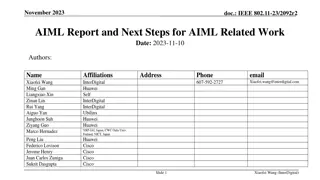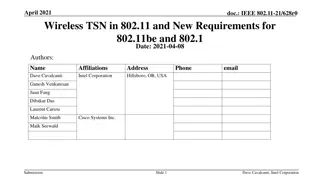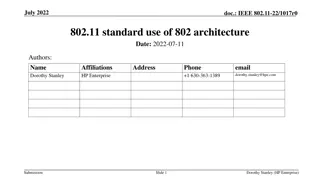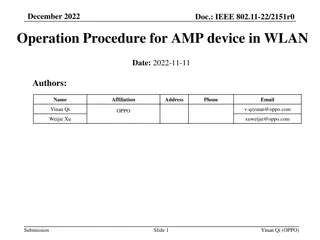IEEE 802.11-19/1215r0 WLAN Integration in 5G System Release 17 Overview
This document discusses the integration of WLAN access as another RAT in the 5G System architecture, emphasizing the progression from 3GPP Release 15 to Release 17. Key points include unified authentication frameworks, QoS provision in managed WLAN, traffic steering mechanisms, and the convergence of core networks for both 3GPP and non-3GPP accesses. Seamless mobility, policy frameworks, and security aspects are also highlighted.
Download Presentation

Please find below an Image/Link to download the presentation.
The content on the website is provided AS IS for your information and personal use only. It may not be sold, licensed, or shared on other websites without obtaining consent from the author.If you encounter any issues during the download, it is possible that the publisher has removed the file from their server.
You are allowed to download the files provided on this website for personal or commercial use, subject to the condition that they are used lawfully. All files are the property of their respective owners.
The content on the website is provided AS IS for your information and personal use only. It may not be sold, licensed, or shared on other websites without obtaining consent from the author.
E N D
Presentation Transcript
July 2019 doc.: IEEE 802.11-19/1215r0 3GPP WLAN integration in 5G System Release 17 Date: 2019-07-15 Authors: Name Affiliations Address Phone email Thomas Derham Florin Baboescu Broadcom Broadcom thomas.derham@broadcom.com florin.baboescu@broadcom.com Submission Slide 1 Thomas Derham, Broadcom
July 2019 doc.: IEEE 802.11-19/1215r0 Abstract This contribution provides (1) a status update on 3GPP Release 15 and 16 work in integrating WLAN access as another RAT in the 5G System architecture (2) a description of the approved work to be continued in Release 17 (3) a proposal for IEEE to indicate in indicating its support to 3GPP SA for the continuation of this work. Submission Slide 2 Thomas Derham, Broadcom
July2019 doc.: IEEE 802.11-19/1215r0 Overview of Rel 15 and 16 work WLAN related work in 3GPP Release 15 and 16 allows terminal devices to use WLAN as a primary access for 5G services. Both 5G capable device as well as non-5G capable devices are supported in accessing 5G services. Seamless connectivity over either 3GPP (NR or LTE) or WLAN is provided based on an unified authentication framework. Both data and control/signaling use an unified transport framework based on IPSec tunneling over WLAN access. When the terminal accesses 5G Services over managed WLAN, QoS is provided, including Guaranteed Bit Rate (GBR) data, similar with the regular 3GPP licensed based access. When the terminal can access 5G services over either cellular or WLAN or both accesses, the access selection and traffic steering (switching and splitting) is provided using a policy based mechanism for both access selection as well as traffic steering. In Release 16, traffic steering and splitting can be done either at an IP flow level or at a packet level for TCP traffic only when MP-TCP proxy is used. Submission Slide 3 Thomas Derham, Broadcom
July2019 doc.: IEEE 802.11-19/1215r0 Release 15 (5G Phase 1): Integration of generic (untrusted) WLAN in the 5G System Defines converged core network architecture with common interfaces (N1, N2, N3) for 3GPP and untrusted non-3GPP(e.g. WLAN) accesses. Defines a unified authentication framework for both 3GPP and non-3GPP accesses based on EAP. The UE is identified by a single 5G Globally Unique Temporary Identifier (5G-GUTI) when it is registered via both 3GPP and non-3GPP access to the same or equivalent PLMN. Seamless mobility among different accesses is supported through the core network. Defines untrusted non-3GPP access (e.g. Untrusted WLAN) architecture and a transport mechanism using IPSec tunnelling over non-3GPP access for both data path and control/signalling (eg. NAS). Establishment of an IPSec tunnel between the terminal and Non-3GPP Interworking Function (N3IWF) uses an IKE exchange that encapsulates a new EAP based procedure (EAP-5G) for authentication. Submission Slide 4 Thomas Derham, Broadcom
July2019 doc.: IEEE 802.11-19/1215r0 Release 15 (5G Phase 1): Integration of generic (untrusted) WLAN in the 5G System A policy framework is supported for Session, Access and Mobility control, QoS and charging enforcement, as well as policy provisioning in the UE. UE Route Selection Policy (URSP) is used by the UE to determine if a detected application can be associated with an established PDU Session, can be offloaded to non-3GPP access outside a PDU Session, or can trigger the establishment of a new PDU Session. Access Network Discovery & Selection Policy (ANDSP) is used by the UE for selecting non-3GPP accesses. URSP and ANDSP are delivered from the Policy Control Function (PCF) to the UE through signalling. A Network Data Analytics Function (NWDAF) is introduced. It can be used on a per-slice level to provide data analytics support on each network slicing load. A flow-based QoS framework has been defined: two basic modes: with or without QoS dedicated signalling. A new QoS type is introduced: "Reflective QoS", where the QoS rules used for downlink are also applied to uplink, to allow symmetric QoS differentiation with minimal control plane signalling. QoS support and provisioning in the WLAN can be provided per IPSec Security Association, whenever it is available. Submission Slide 5 Thomas Derham, Broadcom
July2019 doc.: IEEE 802.11-19/1215r0 Release 16 (5G Phase 2): Integration of managed (trusted) WLAN in the 5G System Based on two main Study/Working Items: Wireless and Wireline Convergence (WWC) Access Traffic Steering, Switch and Split support in 5G System (ATSSS) Wireless and Wireline Convergence(WWC): Achievements (on top of the Release 15 work): Definition of Trusted (managed) WLAN Architecture for 5G System; Unified user plane and control plane protocol stack definition across WLAN Access for both 4G (untrusted) and 5G; Full QoS support and provisioning in the WLAN per IPSec Security Association; Unified authentication framework (EAP based with or without SIM credentials); EAP-5G used for signaling between terminal and TNGF before the first IPSec tunnel setup. Intra TNGF mobility support; Support of WLAN-only devices to access 5G services without SIM based credentials; WLAN access can be provided via: 1) trusted/managed WLAN, 2) residential gateway (with or without NAS and SIM based support) and Cable Modem (with or without NAS and SIM based support); 1. 2. Submission Slide 6 Thomas Derham, Broadcom
July2019 doc.: IEEE 802.11-19/1215r0 Release 16 (5G Phase 2): Integration of managed (trusted) WLAN in the 5G System Access Traffic Steering, Switch and Split Support in 5G Systems (ATSSS): Achievements: Definition of the ATSSS architecture to support traffic steering(switching and splitting) across one or multiple accesses, with a minimized signaling impact to the core network when access conditions change; A new policy based mechanism to control traffic steering across multiple accesses under the control of the Policy Control Function (PCF); It supports a new defined Multi Access PDN which allows data of the same PDN to be handled over one or more accesses; Creates the framework to support different multi-access protocols between the terminal device and an aggregation node, collocated in the UPF, allowing the use of either NR or non-3GPP access or both for the same PDN; It allows support of the following multi-access protocols on the user plane: MP-TCP and ATSSS-LL aka per IP flow splitting (similar to LWIP Rel. 14); It accommodates both Core Network aggregation use cases as well as RAN based aggregation (when UPF is collocated with one or both accesses). It supports both IP and Ethernet PDN; Slide 7 Submission Thomas Derham, Broadcom
July2019 doc.: IEEE 802.11-19/1215r0 Release 17: Further Integration of Managed WLAN in 5G System Continues the two main Study/Working Items from Release 16: Wireless and Wireline Convergence (WWC) SP-190562 Access Traffic Steering, Switch and Split support in 5G System (ATSSS) SP-190558 Study Item Phase to start in October 2019 with the following main goals: (1) continue the integration of the managed WLAN and fixed wireline architecture in the 5G system (2) interworking with 4G (3) new or enhanced protocols for ATSSS user plane. Submission Slide 8 Thomas Derham, Broadcom
July2019 doc.: IEEE 802.11-19/1215r0 Release 17: Further Integration of Managed WLAN in 5G System Wireless and Wireline Convergence(WWC): Objectives: Whether and how to support inter-TNGF mobility for terminal device accessing via trusted non- 3GPP access network. How to improve the support of QoS for a terminal device connected behind an RG via Untrusted and Trusted Non-3GPP access solution. Whether and how to improve the support of devices connecting behind 5G-RG to enable network control based on association between the devices and the 5G-RG. Whether and how a 5G-RG can be simultaneously connected to 5GC via trusted/untrusted WLAN access and via W-5GAN access (WLAN use as a backhaul link to complement fixed wireline/cable access). Submission Slide 9 Thomas Derham, Broadcom
July2019 doc.: IEEE 802.11-19/1215r0 Release 17: Further Integration of Managed WLAN in 5G System Access Traffic Steering, Switch and Split support in 5G System (ATSSS): Objectives: Whether and how to support ATSSS without a multi-access PDU session. Whether and how to support traffic splitting for GBR traffic. Whether and how to support additional steering mode(s) and method(s). Whether and how a UE, under both 3GPP and non-3GPP coverage, can switch traffic from one access to another access based on various conditions, e.g. access quality conditions. Whether and how to support further differentiation of 3GPP accesses within the ATSSS rules and to improve ATSSS rules with conditions related with access quality. Whether additional measurements of the performance of both paths of a multi-access PDU session are needed to better support existing and newly defined steering modes and how such measurements may be performed and improved. Whether and how to support ATSSS for the roaming scenarios which are not supported in Rel-16. Whether and how to support ATSSS for unstructured type PDU Session under the condition that no traffic filter applies within the PDU Session i.e. the traffic of the whole PDU Session is either sent over 3GPP access or sent over non-3GPP accesses Whether and how to support multi-access PDU session with one access leg over EPC and the other access leg over non-3GPP access 5GS. Whether and how to support routing traffic to a secondary PDU Session anchor (using a UPF acting as a UL-CL/Branching point) for multi- access PDU Sessions Slide 10 Submission Thomas Derham, Broadcom
July2019 doc.: IEEE 802.11-19/1215r0 Proposed IEEE 802.11 Actions It is proposed that IEEE 802.11 send an LS to 3GPP SA to: Indicate its support for continuation of the work of integrating WLAN access as another RAT in the 5G System per the following study items: Study on enhancement of support for 5WWC (SP-190562), and Study Extended Access Traffic Steering, Switch and Splitting support in the 5G system architecture(SP-190558) Submission Slide 11 Thomas Derham, Broadcom























